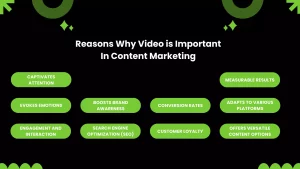Why Video is future of Content Marketing?
The average attention span of users has declined to 8.25 seconds as compared to 2000. And looking at that data, a picture worth a thousand words lacks credibility when you have an interactive video against it. Let us now understand what makes videos, future of content marketing.
54% of consumers want more videos from the brands and companies they follow. No matter the content isi promotional or entertaining, the preferred form of content is video amongst the audience.

The craze is on the rise so much so that brands connect with influencers and create live videos to engage the audience for a longer time. Live video streaming is about authenticity and connection.
Let us see why video makes the future of content marketing?
What is Video Content Marketing?
Video content marketing is a strategy that utilizes videos to promote and advertise products, services, or brands.
- It involves creating engaging and informative video content that resonates with the target audience, encouraging them to take desired actions, such as making purchases or subscribing to newsletters.
- Various forms of video content marketing include product demonstrations, instructional tutorials, behind-the-scenes glimpses, customer testimonials, and animated explainer videos.
- These videos can be shared on multiple platforms, including social media, YouTube, company websites, or email.
- The primary goals of video content marketing are to enhance brand awareness, drive traffic to websites or landing pages, generate leads, and ultimately increase sales.
- This approach connects with audiences emotionally, establishing trust and credibility and building relationships with potential customers.
One example of a brand that has used video content marketing effectively is Nike. Nike has a history of creating visually stunning and emotionally powerful video campaigns that resonate with its target audience.

YouTube Link: Dream Crazy by Nike.
One of Nike’s most popular video campaigns is their “Dream Crazy” campaign featuring former NFL quarterback Colin Kaepernick. The ad showcases a series of athletes who have overcome adversity and achieved success, encouraging viewers to dream big and pursue their goals. The video generated a lot of buzz and controversy and helped reinforce Nike’s brand message of inspiring athletes to reach their full potential.
Nike also frequently uses video content to showcase their products and innovations, such as their “React” foam technology, which provides runners with extra cushioning and responsiveness. These videos typically feature athletes and influencers demonstrating the technology’s benefits while highlighting the shoes’ design and functionality.
Overall, Nike’s video content marketing strategy is focused on inspiring and empowering athletes while promoting their products’ quality and innovation.
Reasons Why Video is Important In Content Marketing

Here are the reasons why video is important in content marketing:
- Reason 1: Video Captivates Attention
- According to a study by HubSpot, videos on social media generate 12 times more shares than text and image content combined. This suggests that videos are more likely to capture people’s attention and engage them enough to share the content with their networks.
- A report by Wyzowl found that 68% of consumers prefer to learn about a new product or service by watching a short video. This suggests that video content can effectively engage consumers and capture their attention when they are considering a purchase or researching a new product or service.
Videos are visually engaging and appealing, making it easier for viewers to pay attention and remain engaged. Videos can use color, movement, and sound to create a more immersive experience for the audience.
One minute video is worth as much as 1.8 million words. Each person spends a minimum of 1 hour and 48 minutes watching videos in 2022. (Techjury).
Video content engages multiple senses – visuals and audio – which help to keep viewers interested and engaged. The combination of sight and sound can create a more immersive and memorable experience for the audience than written content relying solely on text.
- Reason 2: Video Evokes EmotionsA study conducted by Unruly revealed that video content elicits more robust emotional responses from viewers than text or image content. The study demonstrated that individuals are likelier to experience intense emotions like happiness, sadness, or excitement when consuming video content. Furthermore, the study indicated that emotionally charged videos are more likely to be shared on social media, highlighting the potential of video content to engage and become viral.The significance of emotions in marketing cannot be overstated, as it plays a pivotal role in establishing a strong connection with the target audience. Emotions can captivate the audience’s attention, foster empathy, and cultivate long-term customer relationships.Emotional marketing employs storytelling, imagery, and music to evoke emotional responses from the audience. By establishing an emotional connection, brands can enhance customer loyalty, stimulate word-of-mouth marketing, and drive sales.
The utilization of emotions in marketing can be particularly effective in industries such as fashion, cosmetics, and luxury goods, where the emotional appeal of the product is a crucial factor in the purchasing decision. However, this approach can be applied to any industry, as emotions are a universal aspect of human behaviour and can influence consumer choices.
- Reason 3: Video Increases Engagement and InteractionVideo content has gained popularity as a marketing tool in recent years due to its ability to enhance audience engagement and interaction. Unlike written or static images, video content possesses a dynamic nature that is more likely to capture and retain the viewer’s attention. Consequently, this heightened level of engagement often results in increased likes, comments, and shares on social media platforms. Moreover, videos frequently incorporate a call-to-action at the conclusion, motivating viewers to take specific actions such as purchasing or subscribing to a newsletter. By encouraging the audience to actively engage with the brand, the level of interactivity can significantly enhance the effectiveness of the marketing campaign. In summary, video content is a potent tool for augmenting audience engagement and interaction, making it a valuable asset to any marketing strategy.
- Reason 4: Video Boosts Brand AwarenessVideo content is a powerful tool for boosting brand awareness. By producing captivating and visually stimulating videos, companies can exhibit their products or services and convey their brand message in a memorable and impactful manner. Video content is particularly effective in establishing an emotional connection with the audience, which can foster brand loyalty and cultivate a favourable brand image. Furthermore, videos are more likely to be shared on social media platforms, amplifying the brand’s reach and visibility. This, in turn, can result in heightened brand recognition and awareness. Additionally, videos can be optimized for search engines, facilitating potential customers in discovering the brand online. In summary, video content can be a potent tool for augmenting brand awareness and should be an essential element of any brand’s marketing strategy.
- Reason 5: Video Improves Search Engine Optimization (SEO)
Video content has the potential to significantly enhance Search Engine Optimization (SEO) and generate higher website traffic. This is primarily because videos prolong visitors’ stay on a website, a critical aspect that search engines utilize to assess the relevance and worth of a site.
Furthermore, video content can be optimized for search engines by incorporating pertinent keywords in the video title, description, and tags, as well as by including transcripts and captions. These measures can enhance the visibility and ranking of the video in search results, consequently augmenting the traffic directed towards the website.
Additionally, when videos are embedded within a website or shared on social media platforms, they can establish backlinks to the website, thereby enhancing its search engine ranking. In conclusion, video content is a valuable tool for improving SEO and driving increased traffic to a website, rendering it an indispensable component of any digital marketing strategy.
Reason 6: Video Increases Conversion Rates

-
- According to a report by Wyzowl, 84% of people say that they have been convinced to buy a product or service by watching a brand’s video.
- In a study by Eyeview, it was found that adding video to a landing page can increase conversion rates by up to 80%.
- A report by Vidyard found that using personalized video content can increase click-through rates by 985% compared to traditional email marketing.
- According to a study by Unbounce, using an explainer video on a product page can increase conversion rates by up to 144%.
- HubSpot reports that adding a video to a marketing email can increase click-through rates by up to 300%.
- These statistics demonstrate the power of video content in driving conversions and increasing the effectiveness of a business’s marketing efforts. By strategically using video content, companies can create a more engaging and memorable experience for their audience, leading to higher conversion rates and increased revenue.
- Reason 7: Video Enhances Customer Loyalty
- A report by HubSpot found that 54% of consumers want to see more video content from brands they support.
- According to Wyzowl, 91% of consumers have watched an explainer video to learn more about a product or service.
- A study conducted by Animoto revealed that a significant 73% of consumers are more inclined to make a purchase after viewing a video that explains a product or service.
- Additionally, a report by Brightcove found that viewers who watch 50% of a brand’s video content are 22 times more likely to become a customer than those who only watch 25% of the content. Furthermore, a study by
- Wistia indicated that businesses that incorporate video in their email marketing campaigns observe a 20% increase in open rates and a staggering 520% increase in revenue.
- These statistics highlight the potential impact of video content on customer loyalty, sales, and revenue. By strategically utilising video to engage with their audience and foster stronger relationships, businesses can enhance customer loyalty and establish a more devoted customer base.
- Reason 8: Video Provides Measurable Results
- A report by Wyzowl found that 83% of businesses believe that video provides a good return on investment.
- According to Vidyard, 94% of businesses say that video has helped increase user understanding of their product or service.
- In a study conducted by Ascend2, it was discovered that the utilization of video has resulted in an increase in website traffic for 87% of businesses.
- A report from Wistia further supports this finding, revealing that companies incorporating video on their website experience a significant 41% surge in search traffic compared to those who do not utilize video.
- Moreover, a report by Aberdeen Group emphasizes the advantages of video marketing, indicating that businesses employing this strategy observe a 27% higher click-through rate and a 34% higher web conversion rate compared to those who do not utilize video.
- These statistics underscore the tangible impact that video content can have on a business’s marketing endeavours. By strategically implementing video, companies can witness amplified website traffic, improved click-through rates, and enhanced web conversion rates.
- Furthermore, companies can gauge the efficacy of their video content through metrics such as views, engagement, and conversion rates, facilitating the refinement and optimization of their video strategy over time.
- Reason 9: Video Adapts to Various Platforms
- A report by HubSpot found that 72% of people would rather watch a video to learn about a product or service than read text.
- According to Wyzowl, 68% of people prefer to learn about new products or services by watching a short video.
- A study by Animoto found that 84% of consumers have been convinced to make a purchase after watching a brand’s video on social media.
- A report by HubSpot found that video is the most popular type of content shared on social media, with 72% of people saying they share videos with their friends.
- According to a report by Facebook, 75% of all video views on their platform are on mobile devices.
The stats highlight how video content can be adapted to various platforms, including social media and mobile devices, to reach a wider audience and engage with consumers where they are most active.
By creating videos optimized for different platforms and devices, businesses can make a more seamless and practical user experience, leading to improved engagement, brand awareness, and sales.
- Reason 10: Video Offers Versatile Content Options
- According to Wyzowl, 85% of businesses use video as a marketing tool.
- A study by Cisco found that by 2022, online videos will make up more than 82% of all consumer internet traffic.
- A report by HubSpot found that 43% of people want to see more video content from marketers in the future.
- According to a survey by Promo.com, 88% of businesses say that they are satisfied with the ROI of their video marketing efforts.
- In a report by Vidyard, it was found that businesses use video for a variety of purposes, including product demos (50%), social media (46%), email marketing (40%), and landing pages (34%).
These statistics demonstrate the versatility of video content as a marketing tool. Businesses can use video to achieve various goals, from increasing brand awareness and engagement to driving sales and revenue.
Also Read – What is a Video Marketing Strategy?
FAQ
What is video marketing, and why is it essential for businesses?
Video marketing is a strategy that involves creating and using videos to promote products, services, or brand messages. It’s essential for businesses because videos are highly engaging and can convey information in a more memorable and relatable way than text. They can help companies to reach a wider audience, build brand awareness, and drive conversions.
How can I get started with video marketing on a tight budget?
You can start video marketing on a budget using your smartphone to record and edit videos. Focus on creating valuable and informative content. Use free or low-cost video editing software and leverage social media platforms for organic reach. As you see results, consider reinvesting in better equipment and paid advertising for more significant impact.



